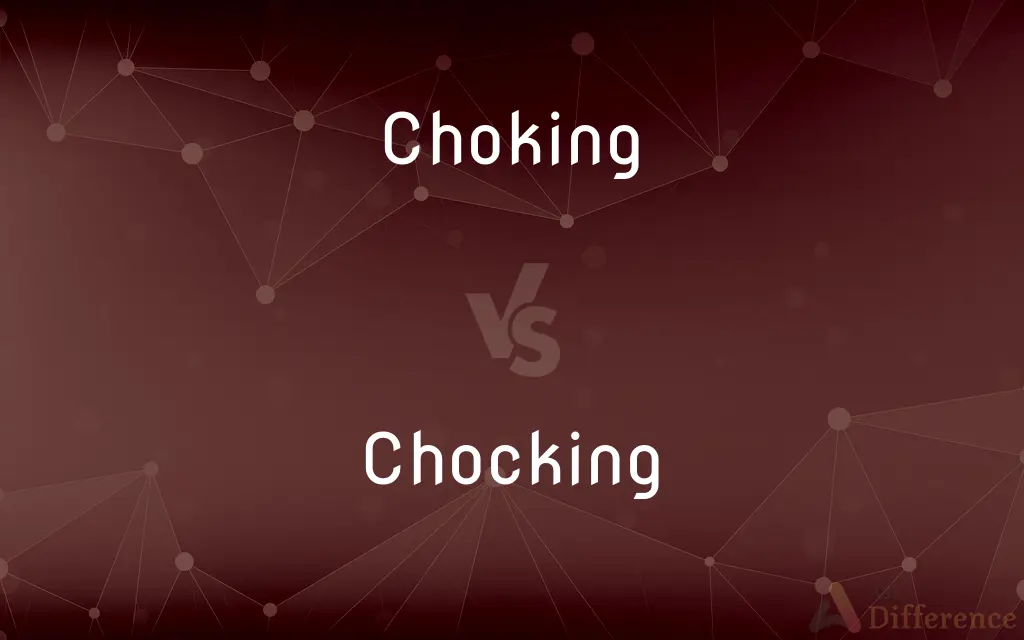Choking vs. Chocking — What's the Difference?
By Tayyaba Rehman & Urooj Arif — Updated on March 25, 2024
Choking occurs when an object obstructs the airway, making breathing difficult, whereas chocking involves placing wedges under wheels to prevent movement.

Difference Between Choking and Chocking
Table of Contents
ADVERTISEMENT
Key Differences
Choking is a medical emergency that happens when a foreign object blocks the airway, making it hard for air to flow into the lungs. This can lead to severe breathing difficulties or even death if not promptly addressed. On the other hand, chocking refers to the action of securing vehicles or machinery by placing wedges, known as chocks, under their wheels to prevent accidental movement. This is a safety measure used in various settings, from aviation to automotive.
While choking can affect any person who accidentally swallows an object too large for their throat, chocking is a preventive measure taken by professionals or individuals to ensure the safety of stationary vehicles or equipment. Choking incidents are medical emergencies that require immediate attention, often necessitating first aid like the Heimlich maneuver. Whereas, chocking is a planned safety procedure implemented in environments where vehicles or machinery must remain stationary.
Choking involves an involuntary response to an obstruction in the airway, leading to panic and distress. It's a situation that demands quick intervention to remove the blockage and restore normal breathing. Chocking, however, is a deliberate act carried out to enhance safety and stability, often in compliance with safety regulations and procedures designed to prevent accidents.
The process of dealing with choking involves medical techniques and sometimes professional medical intervention to clear the airway. This might include back blows, abdominal thrusts, or even surgical procedures in severe cases. In contrast, chocking involves the application of physical objects (chocks) that are placed strategically to ensure that vehicles or equipment do not move. This requires understanding of the proper placement and use of chocks to be effective.
Choking is primarily a concern for human health and safety, emphasizing the importance of awareness and quick response in emergencies. Chocking, while also a safety measure, focuses on the prevention of property damage or accidents caused by the unintended movement of vehicles or machinery. Both processes are vital in their respective contexts for preserving life and preventing accidents, yet they operate in completely different realms of safety and emergency response.
ADVERTISEMENT
Comparison Chart
Definition
Obstruction of the airway by a foreign object.
Placement of wedges under wheels to prevent movement.
Purpose
To remove the blockage and restore breathing.
To prevent accidental movement of vehicles or machinery.
Context
Medical emergencies.
Safety measures in automotive, aviation, and machinery.
Method
Heimlich maneuver, back blows, medical intervention.
Placement of chocks under wheels.
Primary Concern
Human health and safety.
Prevention of property damage and accidents.
Compare with Definitions
Choking
An involuntary response to airway obstruction.
Choking signs include clutching at the throat and difficulty speaking.
Chocking
Involves the use of physical objects to secure stationary positions.
Chocking materials vary, but all serve to keep vehicles stationary.
Choking
A condition requiring urgent removal of the obstruction to prevent suffocation.
During the first aid course, we learned how to assist someone who is choking.
Chocking
The act of placing a wedge or block behind a wheel to prevent movement.
Before working on the vehicle, he made sure it was securely chocked.
Choking
A critical emergency that can lead to death if not quickly addressed.
Quick response to choking can save lives, emphasizing the importance of knowing first aid.
Chocking
A safety measure in the transportation and construction industries.
Chocking the wheels is a standard safety procedure before aircraft maintenance.
Choking
The act of struggling to breathe because of a blocked airway.
The toddler began choking on a small toy, prompting immediate action from the parents.
Chocking
Part of safety regulations and protocols.
The safety audit included checks on the chocking of heavy equipment.
Choking
Pertains to breathing difficulties caused by external objects.
Choking hazards are a major concern in products for young children.
Chocking
Implemented to enhance stability and safety.
Proper chocking prevents accidents in loading docks.
Choking
Choking occurs when breathing is impeded by a constricted or obstructed throat or windpipe. In some cases, the airflow is completely blocked, and in other cases, insufficient air passes through to the lungs, resulting in oxygen deprivation.
Chocking
A block or wedge placed under something else, such as a wheel, to keep it from moving.
Choking
To interfere with the respiration of by compression or obstruction of the larynx or trachea.
Chocking
(Nautical) A heavy fitting of metal or wood with two jaws curving inward, through which a rope or cable may be run.
Choking
To check or slow down the movement, growth, or action of
A garden that was choked by weeds.
Chocking
To fit with or secure by a chock
The plane's wheels were chocked and chained down.
Choking
To block up or obstruct by filling or clogging
Mud choked the drainpipe.
Chocking
(Nautical) To place (a boat) on blocks or wedges.
Choking
To fill up completely; jam
Major commuter arteries were choked with stalled traffic.
Chocking
As close as possible
Had to stand chock up against the railing.
Choking
To reduce the air intake of (a carburetor), thereby enriching the fuel mixture.
Chocking
Present participle of chock
Choking
(Sports) To grip (a bat or racket, for example) at a point nearer the hitting surface.
Choking
To have difficulty in breathing, swallowing, or speaking.
Choking
To become blocked up or obstructed.
Choking
(Sports) To shorten one's grip on the handle of a bat or racket. Often used with up.
Choking
To fail to perform effectively because of nervous agitation or tension, especially in an athletic contest
Choked by missing an easy putt on the final hole.
Choking
The act or sound of choking.
Choking
Something that constricts or chokes.
Choking
A slight narrowing of the barrel of a shotgun serving to concentrate the shot.
Choking
A device used in an internal-combustion engine to enrich the fuel mixture by reducing the flow of air to the carburetor.
Choking
The fibrous inedible center of an artichoke head.
Choking
The process in which a person's airway becomes blocked, resulting in asphyxia in cases that are not treated promptly.
Choking
The act of coughing when a person finds it difficult to breath.
Choking
Present participle of choke
Choking
That chokes; producing the feeling of strangulation.
Choking
Indistinct in utterance, as the voice of a person affected with strong emotion.
Choking
A condition caused by blocking the airways to the lungs (as with food or swelling of the larynx)
Choking
The act of suffocating (someone) by constricting the windpipe;
No evidence that the choking was done by the accused
Common Curiosities
When is chocking necessary?
Chocking is necessary whenever vehicles or machinery need to be secured to prevent unintentional movement, especially on inclines or during maintenance.
What are chocks made of?
Chocks can be made of various materials, including rubber, metal, and wood, depending on the application.
What causes choking?
Choking is caused by a foreign object blocking the airway, preventing normal breathing.
Can choking be fatal?
Yes, choking can be fatal if the airway is not quickly cleared, leading to suffocation.
What are the signs of choking?
Signs include coughing, gagging, inability to speak or breathe, and clutching the throat.
What should you do if someone is choking?
Perform the Heimlich maneuver or back blows to try to dislodge the object, and call emergency services if necessary.
How can choking be prevented?
Choking can be prevented by chewing food thoroughly, keeping small objects out of reach of children, and following safety guidelines.
What age groups are most at risk for choking?
Young children and the elderly are most at risk due to difficulties in chewing or swallowing.
Is chocking only used for vehicles?
While commonly used for vehicles, chocking is also employed to secure machinery and aircraft in place.
How does chocking contribute to workplace safety?
Chocking prevents accidents by ensuring vehicles and machinery do not move unexpectedly, contributing to a safer work environment.
Can chocking fail?
Chocking can fail if the chocks are not properly sized, placed, or if they slip due to poor surface conditions.
How is chocking enforced in industries?
Safety regulations and workplace policies mandate the use of chocking for vehicles and machinery to prevent accidents.
Why is chocking important in aviation?
In aviation, chocking prevents aircraft from moving on the ground, ensuring safety during maintenance and loading operations.
What first aid is needed for choking?
First aid includes back blows and abdominal thrusts (Heimlich maneuver) to remove the obstruction.
Are there alternatives to chocking?
Alternatives include parking brakes and other locking mechanisms, though chocking provides an additional layer of safety.
Share Your Discovery

Previous Comparison
Catalogue vs. Manual
Next Comparison
Code vs. RegulationAuthor Spotlight
Written by
Tayyaba RehmanTayyaba Rehman is a distinguished writer, currently serving as a primary contributor to askdifference.com. As a researcher in semantics and etymology, Tayyaba's passion for the complexity of languages and their distinctions has found a perfect home on the platform. Tayyaba delves into the intricacies of language, distinguishing between commonly confused words and phrases, thereby providing clarity for readers worldwide.
Co-written by
Urooj ArifUrooj is a skilled content writer at Ask Difference, known for her exceptional ability to simplify complex topics into engaging and informative content. With a passion for research and a flair for clear, concise writing, she consistently delivers articles that resonate with our diverse audience.
















































